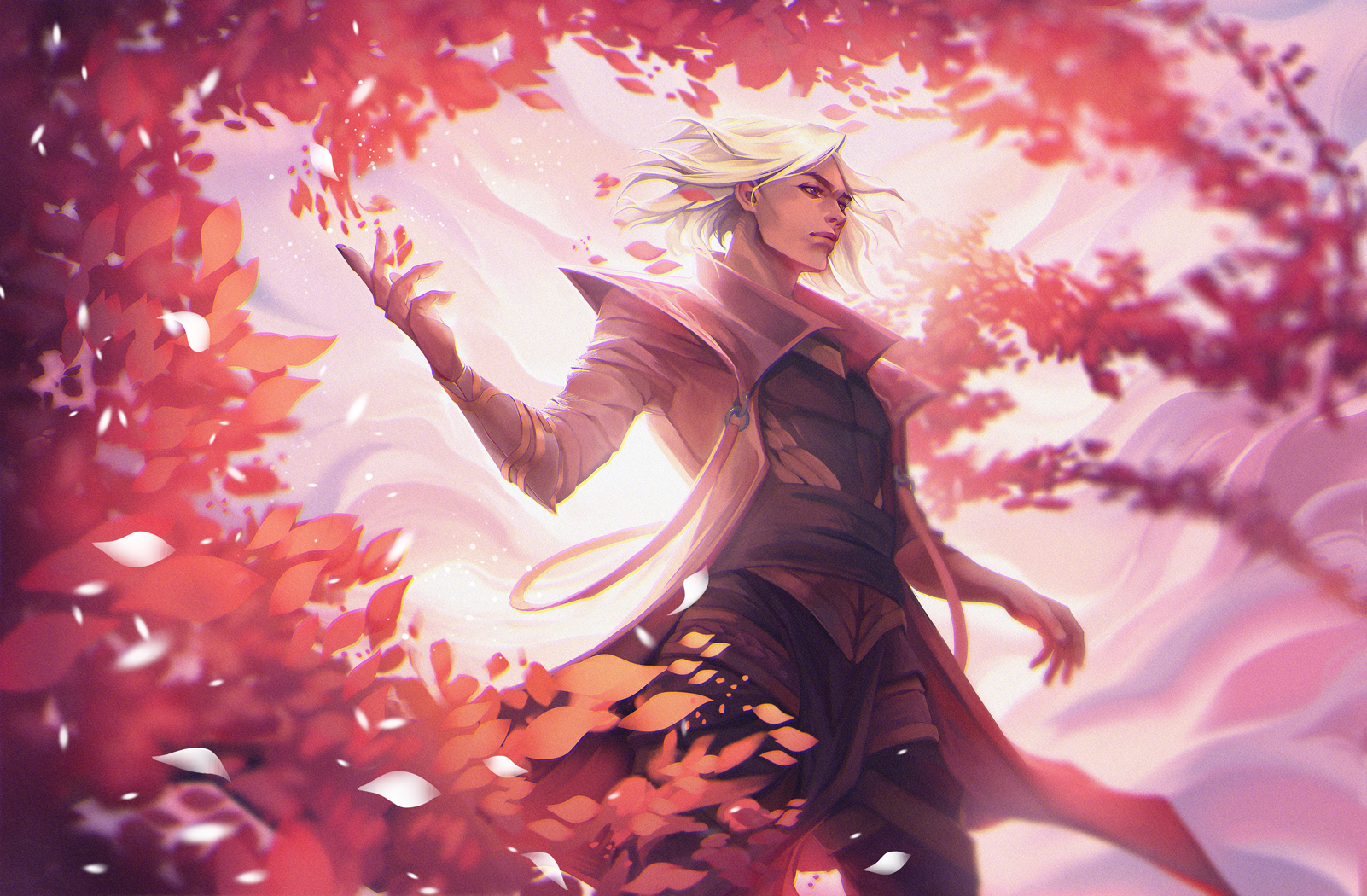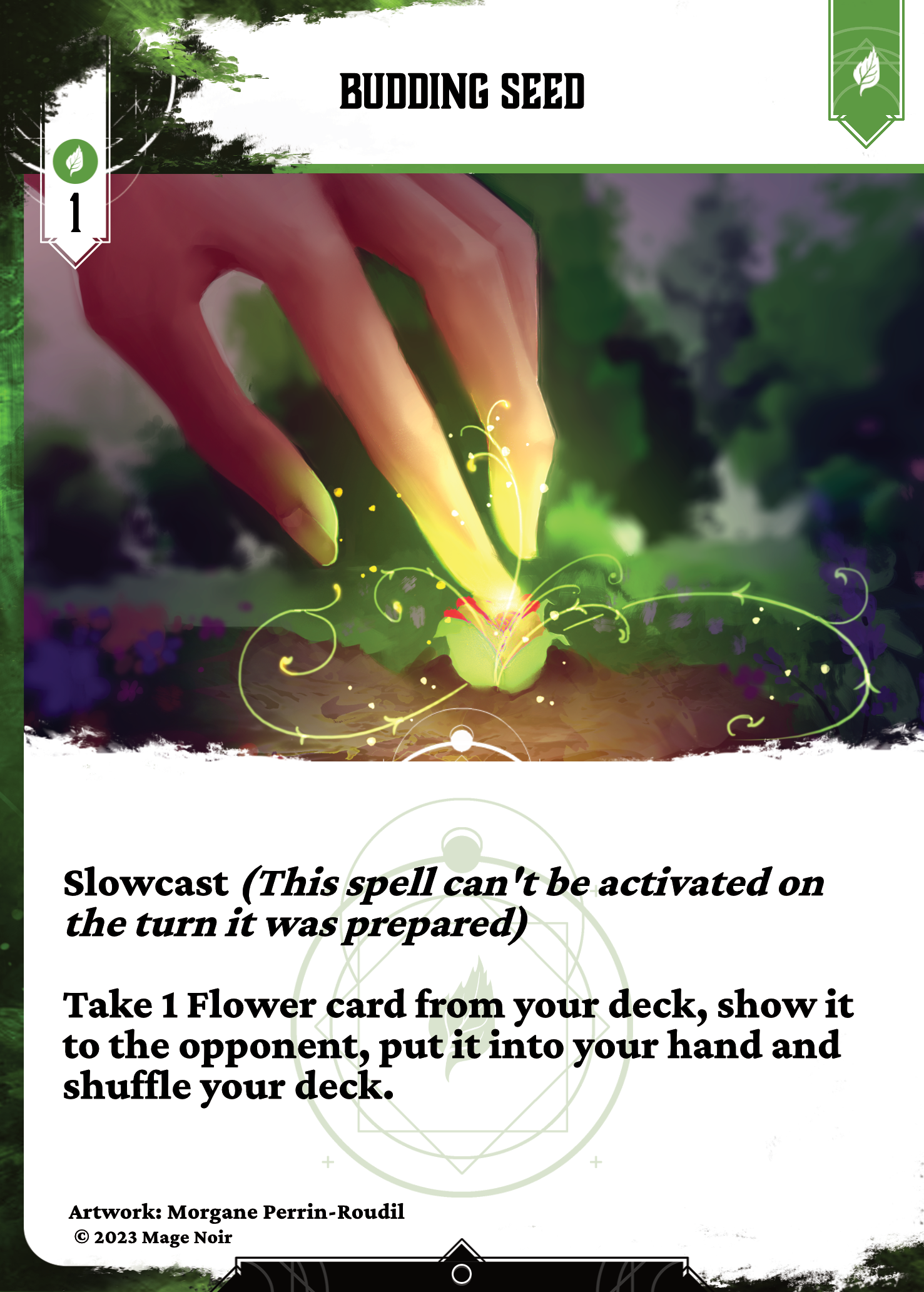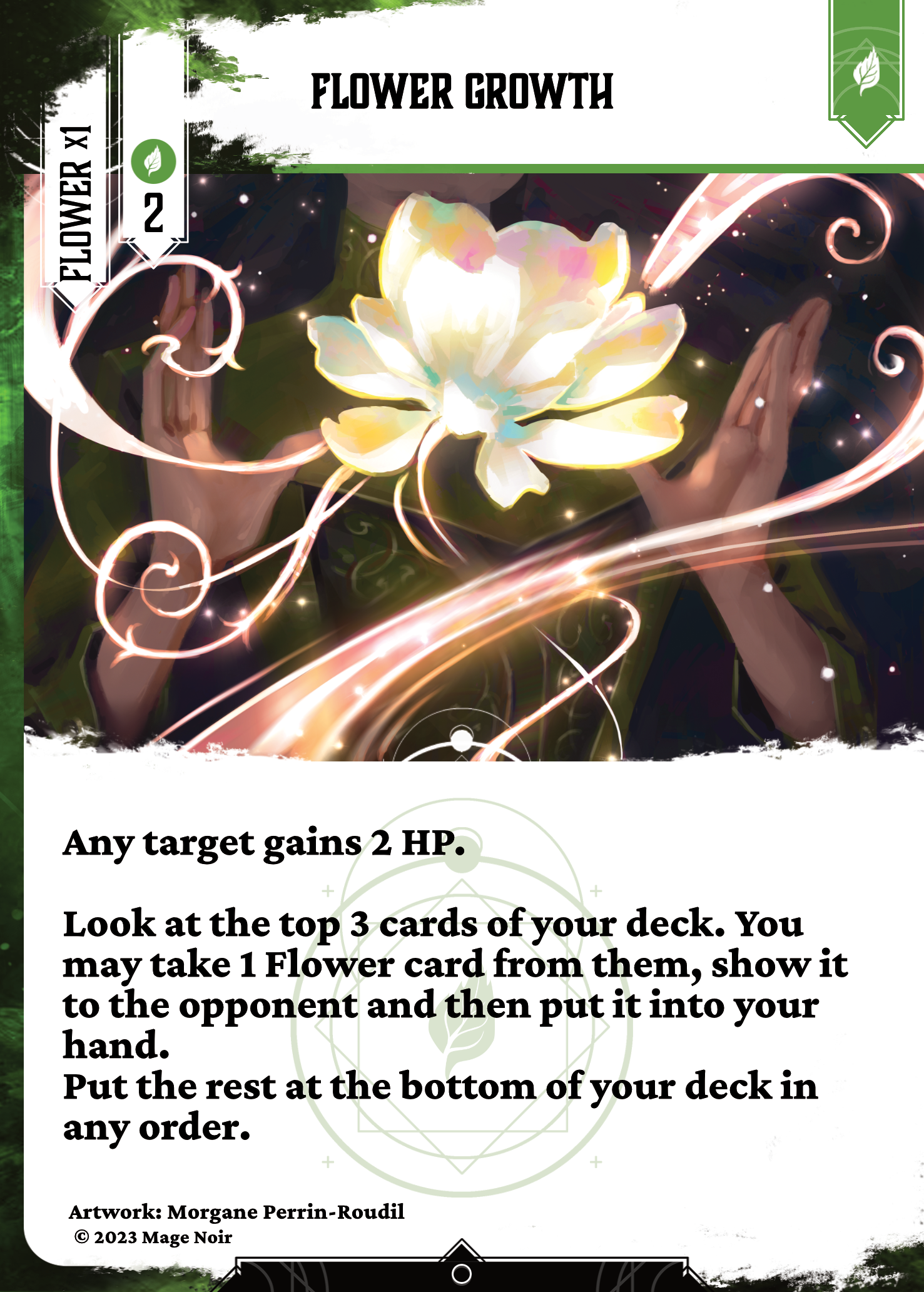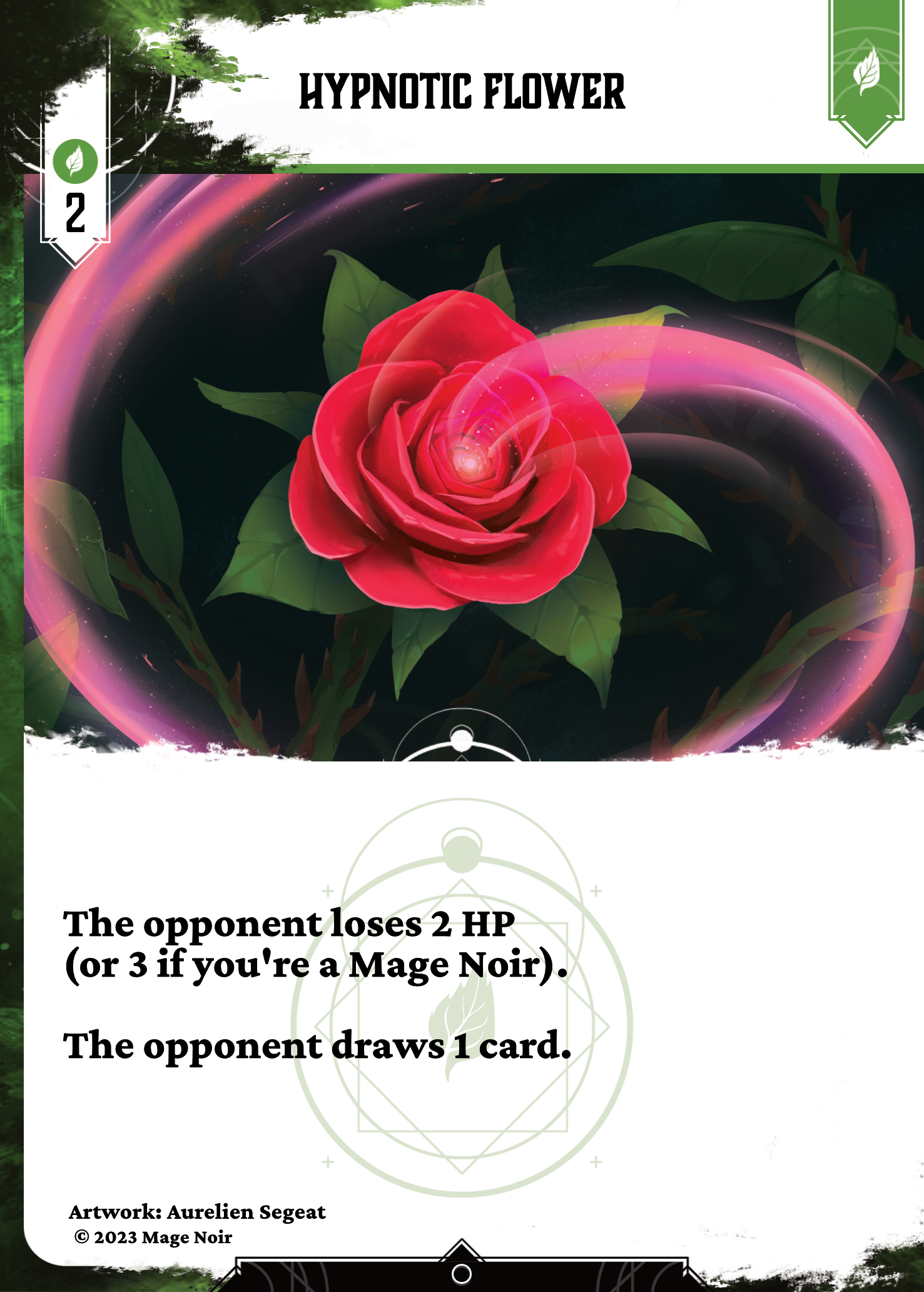Designing the Fleurs expansion
Hi there Mages!
Today we’ll talk about plants, and rather beautiful ones at that. However, beauty does not mean kindness. Today we’ll talk about flowers.

Sharp petals by Jessica Heran
Why go for flowers?
Vegetal and tree decks are fun to play. You put Permanents, they hit for you, they become forests and you are now invincible. It really conveys the power fantasy of an ever growing army. Turning you into the biggest late game threat the Circle knows.
Though it has one big issue: you start weak, and it’s not hard to stop your growth. What if you want that same impression of growth, but with a less risky approach? This is the main question we wanted to answer with this expansion. We thought of a lot of potential candidates for that (and many were very valid), but amongst all these, flowers struck us as the main contender for a simple reason.
Flowers are quite beautiful to look at, don’t they? Sometimes, we hear players asking about when we will have spells about Vampires, esoterism and quite dark subjects.
Through something as simple and beautiful as flowers, we wanted to convey the message that “We get why you ask for it, but it’s not exactly what Mage Noir is about”.
Mage Noir is a game about the beauty of nature and the power of how the scientific approach did wonders for humanity. It picks from the most mundane things and shows how awesome they can be if you look at them from the right angle. Remember, in Mage Noir, magic is science, and science is magic.
This is not the only reason of course, Flowers would still be a great fit for a new Vegetal playstyle, going for wide flower fields instead of getting tall like trees and forest would.
So what are flowers about?
The key concepts of flowers are:
- Spreading
- Ephemeral
- Deceptively harmless
As we explained above, flowers were thought of as the moderate risks, lower rewards alternative to trees in Vegetal. Some players found the Vegetal element to be a bit too slow, or a bit too tedious to get going, which is understandable. Flowers were designed to be a bit quicker to set, but without having late game powerhouses like the forests are.
Druidic discord
By now, many of you should be familiar with the name “Kerloc’h” (or at least know about his robe). He stands among the greatest druids to have ever existed—skillful, kind, and ambitious. Over nearly 81 years, he intricately wove plants and magical augments into his Druid armor, transforming it bit by bit. Intrigued by his prolonged endeavor, other druids decided to pay him a visit. If you’re familiar with the Ship of Theseus, druids have a very strict answer to it. Officially, they judged that Kerloc’h had desecrated the symbol of his membership. In reality, they feared the immense power he would gain upon completing his work. The sentence was the confiscation of his enhanced robe and his banishment.
Kerloc’h’s usual kindness turned to anger as he ruthlessly massacred anyone attempting to take the fruit of his labor. Faced with overwhelming opposition, he was finally forced to retreat, leaving his robe with the remaining Druids.
In present times, Mages who recall this confrontation describe it as the most beautifully horrifying massacre they’ve ever witnessed. Petals were scattered everywhere, and defeated friends were adorned in flowers of vibrant colors, creating a hauntingly beautiful scene. Kerloc’h’s current whereabouts remain unknown, but many fear his eventual return.
What we did with flowers
The first idea was that flowers would “Spread”, meaning that while a tree deck would grow in health and strength, posing larger threats as the game goes on, a flower deck would simply bring the same threats again and again until they can swarm the opponent.
This is why a lot of flowers allow the player to get other flowers. Budding seed or Flower growth are great examples of this concept.


But the other concept that goes really well with this idea is “ephemeral”. A spreading army of ephemeral threats gives a sense of rejuvenation, like you’re constantly replacing the old with the new. The first way to implement this ephemeral concept was of course to give Flowers quite a small health pool. It was obvious, but it lacked depth. We needed to make it stand out, we embraced this idea and used it as a fuel for the archetype.
Thus we created the Autumn keyword. Autumn is the moment when things die so they can live back up in spring. Autumn is the end needed for a new beginning. Which is why Autumn reads: “When it is destroyed, this Permanent applies its start-of-turn effects”.
On top of rendering destruction useful, it also allowed to strengthen the objective of a lower risk playstyle, since you could always benefit from your start of turn effects at least once.
Now the last thing we needed was for Flowers to be “Deceptively harmless”. We would like to precise that “Deceptively harmless” means that it appears to be harmless but it is actually not harmless at all. Funnily enough, having an archetype revolving around killing your plants was already helpful in this regard, as the opponent would see the Flower player hitting his own garden.
The low damage output that flower spells have, along with their various drawbacks makes the expansion seem quite tame at first glance. Bramble flowers are not a threat as long as you don’t hit the opponent’s Permanents. Hypnotic flower is even kind enough to make you draw a card.
But then you dig a bit deeper, and see that the whole can be greater than the sum of its parts.


This is what we wanted to create with this Vegetal expansion. Something that seems unharmful, and even friendly, but that will bring you down sooner than you’d think.
A glass cannon full of petals
What flowers gain in speed however, they lose in defensive abilities. While the forest archetype had ways to defend itself with the Protector keyword, flowers however can only count on bringing their army back up and hoping to survive long enough to see it swarm the opponent.
With a strategy that is not as explosive as fire, or as defensive as Mineral, it has to optimize its plays carefully to keep up the pace, otherwise it will get burned down to a crisp before it can really act.
Because even if strong everlasting spells like “Fractal flower” are wonderful in a war of attrition, they will generate huge losses in tempo against faster paced decks that will go for the throat right away.
That’s it for this blogpost Mages!
We really love how flowers turned out. We think it is a wonderful expansion as it still keeps growth in its core, just like a Vegetal expansion should, yet it sees it in a very different way, bringing a new playstyle on the table while keeping the element’s identity.
We hope you’re ready for the next game design talk though.
Until then, take care of yourselves Mages, and have fun!
~Everyone at Double Combo Games.